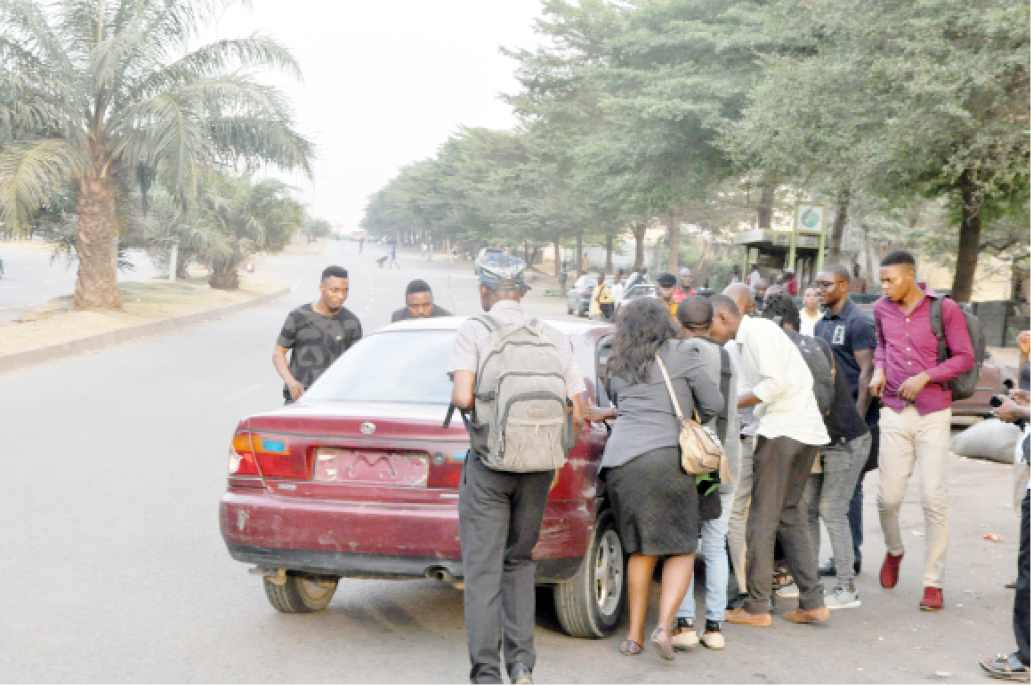The tragedy of the middle-class Nigerians
Generally, the concept of the middle-class challenge or the middle-income trap is grounded in a familiar conventional fact. Low income countries can grow swiftly and graduate to middle-income but then find it challenging to endure rapid economic growth after they reach the middle-income status. One group of such countries that struggled to advance from middle-income […]

Commuters struggle to board a taxi at a bus stop in Jabi Abuja recently.
Generally, the concept of the middle-class challenge or the middle-income trap is grounded in a familiar conventional fact. Low income countries can grow swiftly and graduate to middle-income but then find it challenging to endure rapid economic growth after they reach the middle-income status. One group of such countries that struggled to advance from middle-income to high-income can be exemplified by Latin America, which has become a largely middle-income region years ago and persisted ever after. But even though Latin America can pass for possibly the best case of the middle-income challenge, the poor growth performance of middle-income countries cannot be said to be confined to that region only-even if the Latin American global empirical prevalence produced the concept of the middle-income trap in the first instance.
Thus far, the economic argument on the definition and existence of the middle-class has become particularly active in numerous developing countries. A framework known as the Vulnerability Approach to Middle Class (VAMC) has been used for the middle-class definition such as in estimating the size of any particular middle-class economy through some rigorous measurable means as a way of evaluating its progression over time. And through the VAMC approach, the middle class can be grouped and defined lastingly from the vulnerability analysis as those for which the likelihood of falling into poverty is below a certain edge. Based on data from 2012/13, the Nigerian middle-class show a size from around 20 percent of the total population; with rate of increase of the class typically slower than expected; notwithstanding the high growth rate experienced in the country within the stated periods. The import of all these is that Nigeria may have a heterogenous middle-class population who come across with large spatial variances. It must be stated however, that the southern Nigerian regions tend to have higher share and have experienced higher economic growth within the middle-class group vis-à-vis the northern regions.
In the past couple of years, Nigeria has experienced some economic declines; with their roots traceable to the numerous security challenges in the country. These challenges include the Boko Haram crisis, destabilising the country’s northeast region; the farmer-herder crisis in the Middle Belt region, leading to prolonged and deadly clashes between the mainly Christian farmers and some Muslim cattle herders. Other challenges are the regular protests of the Islamic Movement of Nigeria (an Iranian Shia group), resulting in clashes with the security forces; the Niger Delta crisis in the oil-producing core of Nigeria, as protests over the loss of livelihoods and sources of food for the locals; the likelihood of a civil war in neighbouring Cameroon, calling for the secession of a territory to be called Ambazonia. As a consequence of the secession cause, hundreds of thousands of people have been displaced from their homes with many amongst them fleeing to Nigeria. However, the increasing invasion of refugees into an already fragile Niger Delta region from Cameroon is sure to result in some indefinable consequences, both on the local host communities and the country overall.
While the central government might claim to be working out proactive responses to conflict management through helping to mediate and reduce the conflicts, and as much as through ensuring that proper arrangements are in place in case of incoming refugees, nonetheless, it is safe to say that recent events in Nigeria continues to suggest that middle-class Nigerians will keep bearing the brunt of the indecisions of their leaders. The inactions of Nigeria’s leaders toward the challenges of the country breeds unintended consequences for the middle-class whose existence is continually threatened by the brutally hurt lower-class who would have otherwise found their ways to register their grievances with the upper-class leaders, if they can. But since they do not have considerable access to those in the upper-class category, the grieving lower-class resort to effectively shifting their grievances and criminal objections to the middle-class. Thus, the scenario always plays out simply like this: When the Nigerian leadership in the upper-class refuses to do their job, someone is battered by the economic consequences, and they retaliate by say kidnapping a middle-class Nigerian such as a university professor, whom, by all intents and purposes, is barely surviving-to the extent that they supplement their earnings with say a typing, binding and photocopying business in the garages of decrepit university houses where they live. As insecurity worsens in Nigeria, it is certain that the middle-class Nigerians are in more trouble than they have ever imagined. Interestingly, the middle-class, together with the lower-class would evidently form the majority voting public; and it behoves them to vote for leaders who would ensure their overall safety as a prime interest. Once that is not achieved, then the emergence and sustaining of bad leadership will destroy Nigerians terribly, often with the middle-class bearing the greatest brunt.
